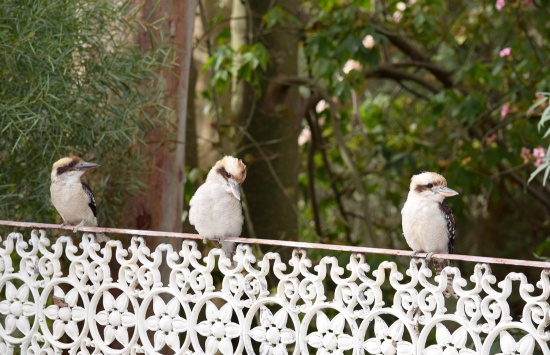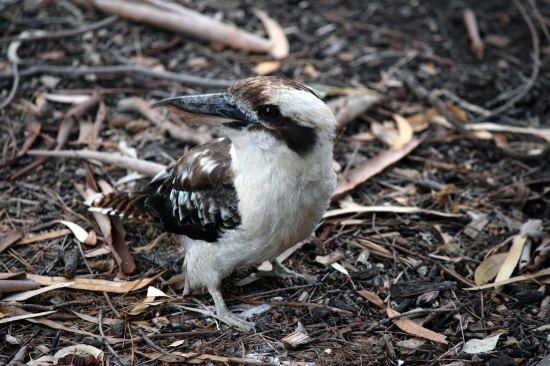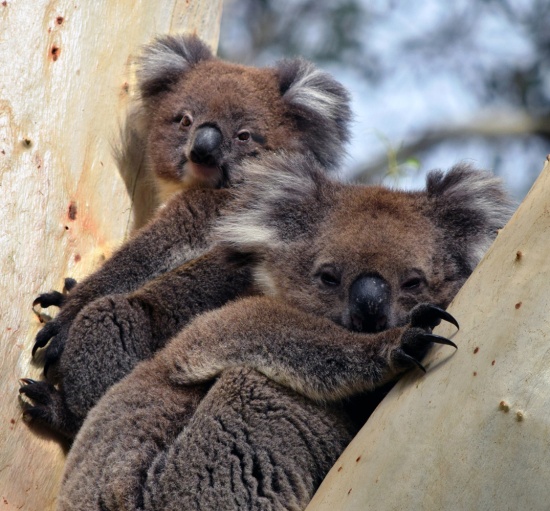The following fauna is familiar in the Australian bush and if you’re lucky you may see it in your backyard..
Perhaps for its iconic bird song alone, the Kookaburra’s distinctive laughter is quintessentially Australian.
It is a member of the Kingfisher family (of which there are more than ten Australian species)* and is also known as the laughing jackass.
It has a large head, a massive neck and bill for catching prey and breaking their necks. Earth tone camouflage plumage and the ability to perch motionless and undetected are ideally suited for catching prey.
*Of these there are strictly only two true kingfishers: the Azure Kingfisher and the Little Kingfisher of the genus Ceyx.
Kookaburra, Dacelo gigas
ii) ‘you can’t see me, i’m camouflaged’
iii) ‘is this real grub?’
iv) three’s a crowd

Aptly named the Blue tongue, the Tiliqua Scincoides or Blue Tongued Skink has a characteristic and distinct blue coloured tongue. It is a relatively large lizard, up to 45cm in length in some cases.
It is ground feeding, omnivorous and its diet includes snails, slugs, fruit, berries, flowers and insects. Grey stripes cover most of its body contrasting with a pale grey belly. The limbs are especially small and the head is a characteristic triangular shape.
It is relatively common in Australian suburbs and can be bred in captivity.
Blue Tongue, Tiliqua scincoides
i), ii) & iii) climbing a step
iv) ‘smile & i’ll crack the lens’ v) distant relative..
The Koala hardly needs an introduction as it is so celebrated and is universally recognised as an Australian symbol. Its closest living relative is the wombat and is found in coastal regions of Queensland, New South Wales, Victoria and South Australia (not Western Australia or Tasmania).
The diet is primarily eucalypt leaves and the limited nutritional and caloric content demands twenty hours of sleep a day.
If you see a koala up a tree alone and drenched in torrential rain, don’t underestimate it. Having especially thick insulating fur (the most of any marsupial) it is specifically adapted to stave off wind and rain as well as solar radiation. Unique body symmetry and long claws mean for tree scaling and effortless mobility in treetops.
Large scale culling of koalas early in Twentieth Century resulted in public outcry and the species is since protected and has established sanctuaries. Re-habitation and breeding programs are re-establishing numbers.
Koala, Phascolarctos cinereus
i) ‘yes, i know i’m handsome but hurry up’
ii) well, hello
iii) two opposable digits for grasping
Champions of navigation and flying, pigeons and doves have adapted to vastly variable habitats. The Crested Pigeon is known for its beautiful head feathers, bright pink legs and feet and its subtle coloured wing feathers. A single ‘woo’ call and a special tinkling sound created during take-off are also distinctive. The Crested Pigeon must have close proximity to water.
Crested Pigeon, Ocyphaps lophotes
i), ii) & iii) ‘yes, i know i’m pretty’
(from Kuku koala)













Hi there all, here every one is sharing these know-how, so
it’s pleasant to read this website, and I used to pay a visit this weblog all the time.
LikeLike
Thank you for the recommendation 🙂
LikeLike
Spot on with this write-up, I honestly believe this
website needs a great deal more attention. I’ll probably be back again to
see more, thanks for the information!
LikeLike
It’s genuinely very difficult in this full of activity life to listen news on TV,
therefore I simply use the web for that purpose, and get the most recent
news.
LikeLike
excellent issues altogether, you just received a logo new reader.
What might you recommend in regards to your
publish that you just made some days in the past? Any certain?
LikeLike
so much excellent thanks a lot for the blog i couldn’t refrain from commenting some genuinely nice stuff on this internet site
LikeLiked by 1 person